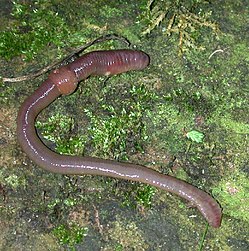| Lumbricidae | |
|---|---|
 | |
| Lumbricus terrestris , the common European earthworm | |
| Scientific classification | |
| Domain: | Eukaryota |
| Kingdom: | Animalia |
| Phylum: | Annelida |
| Clade: | Pleistoannelida |
| Clade: | Sedentaria |
| Class: | Clitellata |
| Order: | Opisthopora |
| Superfamily: | Lumbricoidea |
| Family: | Lumbricidae Rafinesque-Schmaltz, 1815 |
| Genera | |
See text | |
The Lumbricidae are a family of earthworms. About 33 lumbricid species have become naturalized around the world, [1] but the bulk of the species are in the Holarctic region, from Canada (e.g. Bimastos lawrenceae on Vancouver Island) and the United States (e.g. Eisenoides carolinensis, E. lonnbergi , and most Bimastos spp.) and throughout Eurasia to Japan (e.g. Eisenia japonica, E. koreana, and Helodrilus hachiojii). An enigmatic species in Tasmania is Eophila eti . Currently, 670 valid species and subspecies in about 42 genera are recognized. [2] This family includes the majority of earthworm species well known in Europe and Asia.